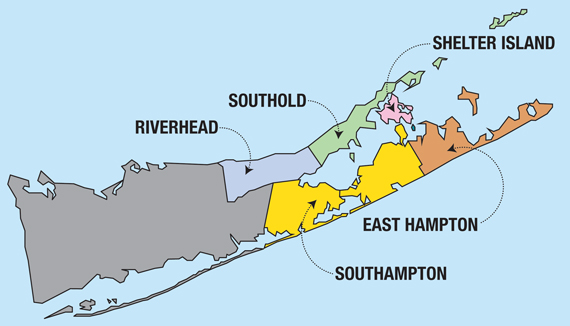Trending
Big development plans for the East End, despite impediments
Developers trying to build in exclusive North and South Fork enclaves face challenges, including bureaucratic red tape, land scarcity and local opposition

While much of Long Island is known for its suburban sprawl closer to New York City, the relatively rural eastern end of the island still has plenty of wide-open spaces. But perceptions are all relative. Just ask any longtime resident who has watched the East End transform from a farming community into a world-class beach resort and see if they feel the area is still bucolic.
Locals grumble that there has already been overdevelopment in the island’s Twin Forks region, which includes the Hamptons. Certainly, there’s intense pressure to build on the East End, which encompasses the five easternmost townships in Suffolk County: East Hampton, Riverhead, Shelter Island, Southampton (which includes the unincorporated area of Westhampton) and Southold. Experts estimate that home prices in those areas are roughly double what they would be for comparable properties in the western part of the county.
Traditionally, local authorities have tried to keep a lid on development, using various zoning regulations. One popular means of curtailing building activity is increasing the acreage required to build a new single-family home. The practice is a common method for municipalities to use in their attempts to preserve open space, either to outright prevent land from being purchased for development, or so that the local government can buy the land themselves for open-space preservation without too much competition from other would-be buyers.
In 2013 the Town of Southold created new zoning for all 840 acres of Plum Island, a federally owned three-mile narrow strip of land located just off the coast of Orient Point on the North Fork. Because this was federal government property, it effectively had no local zoning before the town took action. The U.S. has been considering selling the island for years, sparking concern among local officials and environmentalists alike.
The new zoning Southold put in place created a Plum Island research district and a conservation district, which would be a nature preserve on the island. Now, if the federal government sold the land, the local zoning would protect it from being developed. As it so happens, in May 2016, the U.S. House of Representatives voted against selling the island. The bill halting the sale must still be passed by the U.S. Senate before it may be signed into law.

Alec Baldwin
Developers are often frustrated in their efforts to build on the East End. Local authorities have imposed much red tape, and residents frequently adopt a “Not in my backyard” attitude, both of which can cause long delays, said Dr. Lee Koppelman, a former regional planner for Nassau and Suffolk Counties who is now the executive director of the Center for Regional Policy Studies at Stony Brook University. “Local governments make it increasingly difficult for builders, or individuals who want to build,” he said. “Their regulations are extremely tough to meet.”
Yet the tide may be turning. Land-use loopholes and muscular local development authorities with the ability to impact zoning laws have given rise to a spate of new high-density projects — some that already have shovels in the ground, and others that are still struggling to win approval. Some of the projects would bring light manufacturing, suburban office parks or affordable housing to a region that is more associated, at least in the popular imagination, with movie stars and CEOs.
Naturally, these projects have their fans and detractors, including some high-profile opponents. After all, it is the Hamptons.
East Quogue
A new 118-unit housing development and golf course is planned for the quiet hamlet of East Quogue, which is located within the Town of Southampton. The Hills at Southampton, as the project is known, calls for single-family homes, condominiums and cabins situated on a 168-acre site, part of a 600-acre parcel purchased by the developer in 2011. Pending approval, shovels would break ground in 2017, with the golf course slated to open by 2019, and the last of the homes hitting the market in 2020.
Discovery Land Company, the Scottsdale, Arizona-based developer, has built similar golf-centered resort communities throughout North America. In order to win approval for this project, executives are hoping to make use of Southampton’s Planned Development District legislation, known locally as the PDD law. Modified in 2010 and 2011, this amendment to the town zoning code permits higher-density development than the local zoning allows, in exchange for community benefits.
Although a golf resort conforms to the Hamptons stereotype more than some other planned high-density projects, local critics abound. Actor Alec Baldwin, a Long Island native who has a home in nearby East Hampton, recorded a public service announcement railing against this project that has aired repeatedly on local television. “The biggest and baddest development on Long Island is The Hills at Southampton,” Baldwin said in the two-minute commercial. “It is the largest privately owned Pine Barrens parcel remaining on Long Island.”
Bob Deluca, president and CEO of Group for the East End, a nonprofit advocacy group based in Bridgehampton, is a frequent public critic of the project, and of the law that might enable it. “The PDD process has gained significant popularity among developers because it essentially wipes out a parcel’s underlying zoning,” Deluca told The Real Deal.
All of the public pressure might be having an effect. In May 2016, Southampton placed a one-year moratorium on the review of new PDD applications, which would not affect existing applications like the one for The Hills at Southampton. Deluca and other environmental activists would prefer to put an end to the PDD process altogether. “We must set firm limits on growth,” he said. “We simply cannot sustain the region on the land-use patterns and policies that have urbanized so much of western Long Island.”

“Walking Figure”
Since the public outcry, Discovery Land Company has offered a variety of concessions should it win approval for construction, including a onetime $700,000 donation to the local school district’s capital fund, a new $200,000 playground for the local elementary school and land for the Suffolk County Water Authority. Company representatives declined to comment for this article.
Amagansett
A few miles away, the unincorporated hamlet of Amagansett in East Hampton is mounting opposition to a very different residential project. The East Hampton Housing Authority has proposed a 40-unit affordable housing complex with 15 buildings, including 12 one-bedroom, 12 two-bedroom and 12 three-bedroom apartments renting from $1,100 to $2,300 a month. A family of four with a total annual household income of $106,200 or less would qualify, while 20 percent of the units would be available to Section 8 applicants. Located on a 4.6-acre site at 531 Montauk Highway, the $18 million housing project is expected to begin leasing in 2019.
“You can count the multifamily projects in East Hampton on one hand,” Catherine Casey, the housing authority’s executive director, told TRD. She said that East Hampton’s newest multifamily project was built nearly 30 years ago, and it is all market-rate apartments.
An online petition protesting the housing development has gathered more than 200 signatures. “We believe that this project will have a negative impact on our water quality, traffic, emergency services, property taxes, the Amagansett School, our public utilities, and natural resources,” the petition states. A supporter of the petition commented on Facebook that an “eclectic mix of bohemians and billionaires, somehow all find a way to live together,” in Amagansett, adding, “Who are the EH Housing authority to insist on changing that without our permission!”
Casey disagrees with the critics. “Aside from the waterfront mansions,” she said, many of the locals are low- to moderate-income. Although the housing authority has been conducting some town hall meetings to address residents’ concerns, the land has had the necessary zoning for a project like this to proceed for decades. “We would like Amagansett’s approval,” Casey said, “but we don’t need it.”
Westhampton Beach
Francis S. Gabreski Airport — a small airport that’s been active since World War II — sits four miles north of Westhampton Beach’s central business district. Zoning changes in 2007 increased the potential to develop the airport’s surplus land for industrial usage.
Rechler Equity Partners, a Long Island real estate company based in Plainview, New York, won the bid to develop a 50-acre parcel within the airport, in 2009. Their plans for the Hampton Business District would ultimately include 440,000 square feet of new commercial and industrial space, including corporate offices, medical offices, showrooms, light manufacturing, warehouses and distribution centers.
The developer broke ground in 2014. After opening its doors in January 2015, the first 60,000-square-foot industrial building is 85 percent leased by tenants such as AC Electric, Carrier Air Conditioning and Tate’s Cookies. A second building has been approved, a 68,000-square-foot structure slated to open in spring 2017. With the anticipated completion of the industrial park in 2024, the project will be comprised of nine buildings in all, including a 145-room hotel situated within the airport’s 1,451 acres. It is expected to cost $100 million.

Mitchell Rechler
Mitchell Rechler, one of the real estate company’s managing partners, said the industrial complex was something new on the East End. “The big challenge was going in and creating a market that didn’t exist,” he said, noting that the few existing industrial buildings in the area tended to be run-down, older buildings.
The only vocal objection to the new office park has been a heated debate on the Facebook page of the local Chamber of Commerce about the site’s 30-foot aluminum permanent art installation, titled “Walking Figure,” which was created by New York artist Donald Baechler and commissioned by Rechler Equity Partners. At the time it was installed, an online outcry against the piece of art generated coverage in local papers and the New York Post.
“We think the discussion was great,” Rechler said. “People often take pictures of it and Instagram it out.”
Yet local civic groups have largely supported the redevelopment of the airport’s surplus property for commercial and industrial purposes. While the airport’s redevelopment plan was being formulated in 2006, the New York Times reported that the East Quogue Civic Association — a group that still complains about noise levels from the aviation traffic today — was not opposing the plans at that time to develop the site for non-aviation uses.
Riverside
Renaissance Downtowns, a Long Island developer based in Plainview, has proposed a master plan for a mixed-use development on a 468-acre parcel in the hamlet of Riverside, which is on the western end of the Town of Southampton. In stark contrast with the exotic, moneyed image of the Hamptons, Riverside is an impoverished community where the average median income is $34,000 a year. There’s little doubt that development could potentially benefit this economically challenged zip code.
“The Town of Southampton took on the bold responsibility of providing workforce housing for the entire East End of Long Island,” said Sean McLean, the vice president of development and planning for Renaissance Downtowns, who is a resident of neighboring Flanders himself.
“Preserving the area’s workforce — EMS workers, teachers, police, firefighters — all the professions that make this place function, is critically important,” McLean told TRD.
During a public meeting held by the developer, the residents voted to officially name the project Riverside Rediscovered. The plan, which is still under review by authorities, calls for 2,267 new housing units — a combination of affordable housing and market-rate apartments — more than 133,000 square feet of retail space, and 62,000 square feet of professional and medical offices.
The developer is working with Suffolk County, New York State and the two municipalities that share oversight of the hamlet — the towns of Riverhead and Southampton — to finance the necessary infrastructure upgrades to support the project. Among other things, a new sewage treatment plant is needed before the project can begin construction.
Renaissance Downtowns has embraced the idea of “placemaking,” a relatively new buzzword in the development industry that refers to soliciting community opinion, both online and through public community forums. “Residents in Riverside have never been engaged in their community at this level as they are now,” said Siris Barrios, the developer’s community liaison.
While every project has naysayers, most East End residents feel that something must be done to improve the blighted area. “There will be an increase in traffic,” the Riverhead News-Review reported a local supporter saying at a November 2015 public hearing about the proposed redevelopment project. “But that’s the traffic I want to see — not the drug dealers and the prostitutes.”
Yet even when it comes to a depressed area like Riverside, there was public disagreement about the best way to balance growth with the quality of life. At the same public hearing, a resident who opposes the project said, “This is allowing a tremendous amount of density and a tremendous amount of development that is starting to look like Queens.”
Regardless, the rezoning necessary for the project to proceed was unanimously approved in December 2015.




